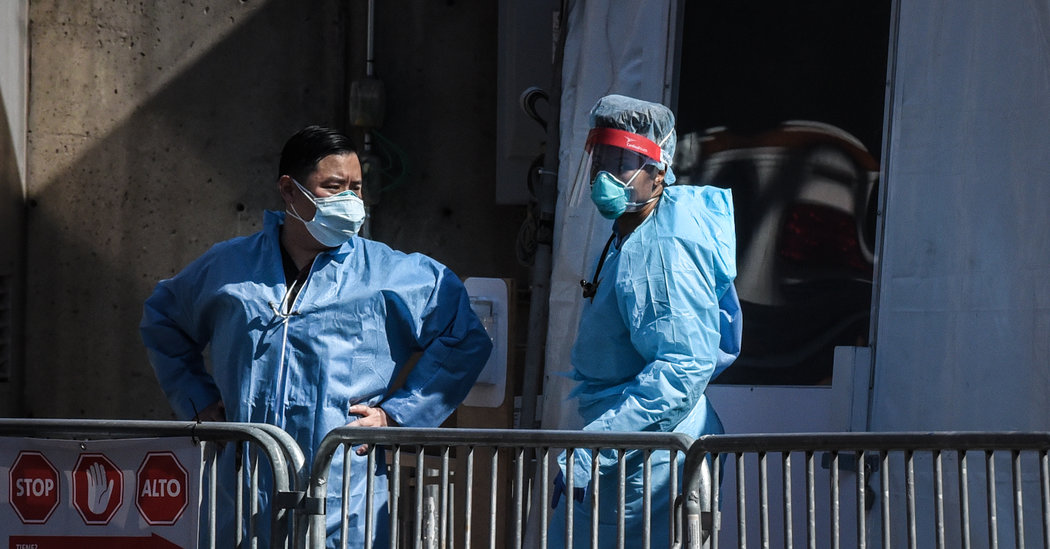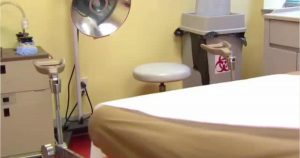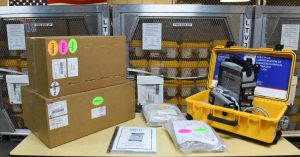Federal and state officials expressed growing alarm on Tuesday about the coronavirus outbreak in New York City, warning that it could reach its peak much sooner than expected and advising people who have passed through or left the city that they should place themselves in a 14-day quarantine.
Dr. Deborah L. Birx, the White House’s coronavirus response coordinator, indicated that the health authorities were now treating the New York City region as a coronavirus hot zone, akin to areas of China and Europe overwhelmed by the virus.
Dr. Birx said that about 60 percent of all the new cases in the United States were in the New York City metropolitan area, adding that a surge in cases on Long Island showed that people leaving the city were spreading the virus.
“Everybody who was in New York should be self-quarantining for the next 14 days to ensure that the virus doesn’t spread to others no matter where they have gone, whether it’s Florida, North Carolina or out to far reaches of Long Island,” she said. “We are starting to see new cases across Long Island that suggest people have left the city.”
Vice President Mike Pence made it clear that New York City was now the nation’s coronavirus epicenter: “We have to deal with the New York metropolitan area as a high-risk area,” he said, telling New Yorkers, “We are with you.”
The White House warning came as Gov. Andrew M. Cuomo offered a grim forecast for the outbreak in New York, saying that it would flood the state’s strained hospitals with as many as 140,000 stricken patients in the next few weeks.
Mr. Cuomo said that in New York City, new cases appeared to be doubling every three days. The crisis has already claimed the lives of more than 200 people statewide, and 131 in the city.
Despite the city’s draconian efforts to slow the spread of the virus, Mr. Cuomo said the number of infections could reach its peak by mid-April, far outrunning earlier projections.
“We haven’t flattened the curve and the curve is actually increasing,” Mr. Cuomo said. “The apex is higher than we thought and the apex is sooner than we thought. That is a bad combination of facts.”
Confronting what he called these “astronomical numbers,” Mr. Cuomo, who has generally been restrained in his criticism of President Trump during the crisis, lashed out for the first time at Washington’s response. He chastised the Trump administration for sending too few respirators to address the crisis and drew an instant rebuke from the president.
The governor’s warnings came as millions of city residents sat hunkered in their homes and as all of its nonessential businesses — such as retail stores, barber shops and nail salons — were shuttered. One survey showed about a third of city residents had lost a job because of the epidemic or lived with someone who had.
Schools have been closed for more than a week and the typically crowded subways and buses were running at record-low capacities. Normally bustling streets were ghostly and empty.
As the number of cases in the city neared 15,000, the police launched a new series of patrols to encourage people to stay inside and to practice the appropriate “social distancing” that health experts recommend in order to stop the spread of the virus.
In the expanding web of the outbreak, emotions ran high: More and more New Yorkers were starting to discover that their colleagues, friends and relatives were falling ill and dying. So far, 131 have died in the city.
“This crisis again, it’s not just numbers,” said Mayor Bill de Blasio. “It’s not just something happening somewhere else or to somebody else. This is something we all will feel very directly in our lives before it’s over.”
Speaking at the Jacob K. Javits Convention Center in Manhattan, a sprawling complex that the U.S. Army Corps of Engineers was scrambling to turn into a 1,000-bed hospital, Mr. Cuomo painted a bleak picture of the days and weeks ahead.
He projected that the state would soon require up to 140,000 hospital beds when only about 53,000 were now available for use. He also said that doctors could ultimately need as many as 30,000 ventilators when only a fraction of that number — somewhere around 5,000 — were currently available.
On Monday, federal emergency officials announced that they were sending 400 ventilators to the state, a figure that Mr. Cuomo said barely dented what local officials desperately required.
“You want a pat on the back for sending 400 ventilators,” Mr. Cuomo said. “What are we going to do with 400 ventilators when we need 30,000 ventilators? You’re missing the magnitude of the problem.”
Not long after Mr. Cuomo spoke, Vice President Pence announced that an additional 4,000 ventilators were either on their way or would soon be sent to New York State.
The breathing machines were only one part of a landslide of medical equipment being rushed to hospitals in the city and its suburbs: 340,000 new N95 respirator masks; 145,000 new surgical gowns; and 350,000 new pairs of gloves.
But even in such large amounts, the fresh supplies might not be enough to stave off disaster in the next two months, Mr. Cuomo said.
Sounding both alarmed and deeply frustrated, the governor said that he was baffled that the federal government had not done more. That prompted immediate criticism from Mr. Trump, who suggested that Mr. Cuomo had made choices years ago to forgo purchases that led to the shortages.
“I watch him on this show complaining,” Mr. Trump said of Mr. Cuomo. “He had 16,000 ventilators, he could have had a great price and he didn’t buy them.”
New York’s hospitals, struggling to treat the surge of new patients and keep their staffs from getting ill, dropped into a defensive crouch.
Two of the city’s biggest hospital networks, NewYork-Presbyterian Hospital and the Mount Sinai Health System, both implemented restrictive visitor policies that barred spouses, partners and other supporters from delivery rooms. The policy meant that mothers would now have to delivery their babies without help from friends, family or doulas.
“I have so much anxiety now and literally have not stopped crying after hearing that my husband can’t be with me,” said Samantha Moshen, 37, whose baby is due in early June.
Judy Sheridan-Gonzalez, an emergency room nurse at a hospital in the Bronx affiliated with Montefiore Medical Center, said that staff members at her facility, like many in the city, had been told to reuse their masks and other protective equipment.
On Sunday, she said, a shipment that Mr. Cuomo promised finally arrived, providing a reprieve for panicked workers.
“It was like Santa Claus came for Christmas,” said Ms. Sheridan-Gonzalez, the president of the New York State Nurses Association. “It was an unbelievable scene. It was like getting party favors. I never saw anything like it.”
In many ways, experts say, New York was fighting an uphill battle against the virus because of one of the city’s most distinctive qualities — its density.
New York has many more residents per square mile than any other city in the country, and those crowded conditions appear to have allowed the virus to spread quickly through apartment buildings, subway cars and jam-packed parks. Federal officials say the city has an extremely high infection rate of one case for every 1,000 people.
Some city residents have chafed at the restrictions, continuing to play sports in parks and to allow their children to interact on playgrounds. At an afternoon news conference, Mr. de Blasio said that the authorities were giving city residents until Saturday to prove that they could safely stay away from each other.
“If it is not sufficiently clear,” he said, “that New Yorkers are following these rules, at that point, we will shut down playgrounds.”
Mr. de Blasio also said the city was seeking to immediately release about 300 inmates at Rikers Island who had been jailed for misdemeanors and other nonviolent offenses. Health officials have warned the epidemic could have disastrous consequences inside city jails.
Officials will also work to determine whether to release about 100 other people in the city’s jails who were awaiting trial, and about 700 more who were there on parole violations, the mayor said.
The mayor became emotional as he discussed the death in Florida on Tuesday of his friend, the Broadway playwright Terrence McNally, 81. Schools official said that Dezann Romain, the 36-year-old principal of the Brooklyn Democracy Academy, had also died of the virus.
Though the New York area was the current epicenter of the outbreak in United States, Mr. Cuomo cautioned that it was also “the canary in the coal mine” for the rest of the country.
“What happens to New York is going to wind up happening to California and Washington State and Illinois — it’s just a matter of time,” he said. “We’re just getting there first.”
Michael Schwirtz and Christina Caron contributed reporting.



















